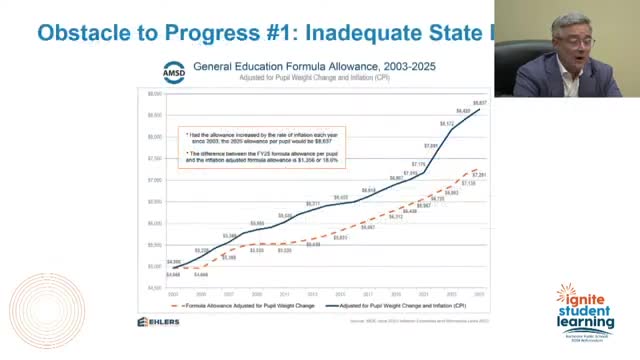Rochester schools face financial crisis as referendum looms
September 10, 2024 | Rochester Public School District, School Boards, Minnesota
This article was created by AI summarizing key points discussed. AI makes mistakes, so for full details and context, please refer to the video of the full meeting. Please report any errors so we can fix them. Report an error »

In a recent government meeting, officials addressed the pressing financial challenges facing Minnesota's school districts, particularly focusing on the upcoming referendum set for November 5th. The discussions highlighted a significant structural deficit attributed to inadequate state funding and local voter-approved support for education.
The meeting revealed that if state funding for the general fund had kept pace with inflation, funding per student would be 18.6% higher than current levels. This disparity has left districts like Rochester, which ranks last among the 15 largest school districts in local voter-approved support, with only $943 per student compared to the state average of $2,120.
To combat this financial strain, the district previously attempted a $10.1 million referendum aimed at technology funding, which narrowly failed by just 318 votes. This setback forced the district to make drastic budget cuts, impacting staff and educational programs. However, a $10 million investment from Mayo Clinic provided temporary relief, allowing the district to stabilize without further staff reductions.
Community feedback following the referendum's failure emphasized the need for clarity in funding proposals and a direct request for necessary financial support. As a result, the district is now proposing a new operating levy aimed at addressing a projected $19.4 million deficit for the 2025-26 school year. If approved, the levy would increase funding to $2,076 per student, with an estimated property tax increase of $29 per month for homes valued at $350,000.
The proposed funding will primarily support positions that assist students requiring additional help, accounting for approximately $3.3 million of the total funds. The district is urging community members to consider the implications of the referendum, emphasizing the critical need for stable funding to maintain educational quality and support for students.
The meeting revealed that if state funding for the general fund had kept pace with inflation, funding per student would be 18.6% higher than current levels. This disparity has left districts like Rochester, which ranks last among the 15 largest school districts in local voter-approved support, with only $943 per student compared to the state average of $2,120.
To combat this financial strain, the district previously attempted a $10.1 million referendum aimed at technology funding, which narrowly failed by just 318 votes. This setback forced the district to make drastic budget cuts, impacting staff and educational programs. However, a $10 million investment from Mayo Clinic provided temporary relief, allowing the district to stabilize without further staff reductions.
Community feedback following the referendum's failure emphasized the need for clarity in funding proposals and a direct request for necessary financial support. As a result, the district is now proposing a new operating levy aimed at addressing a projected $19.4 million deficit for the 2025-26 school year. If approved, the levy would increase funding to $2,076 per student, with an estimated property tax increase of $29 per month for homes valued at $350,000.
The proposed funding will primarily support positions that assist students requiring additional help, accounting for approximately $3.3 million of the total funds. The district is urging community members to consider the implications of the referendum, emphasizing the critical need for stable funding to maintain educational quality and support for students.
View full meeting
This article is based on a recent meeting—watch the full video and explore the complete transcript for deeper insights into the discussion.
View full meeting
